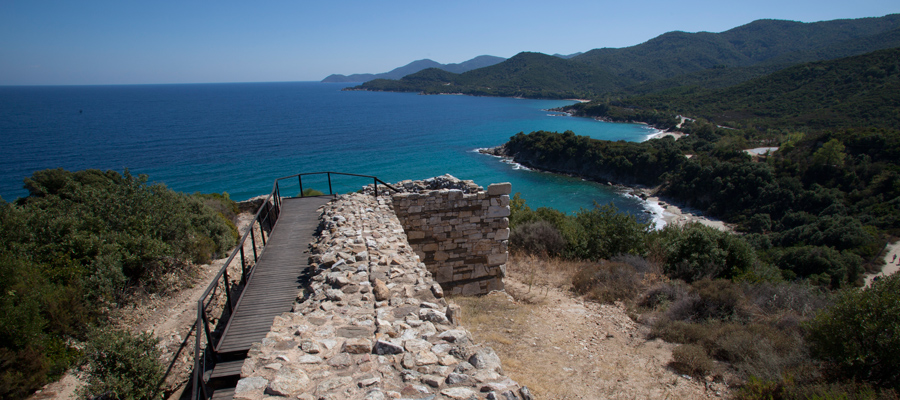Ancient Stagira
The most important historic site in Halkidiki is ancient Stagira, located beside Olympiada, in the Liotopi peninsula. The tour is a real treat. If you want to see everything, you should know that you will need at least 2 to 3 hours and do not miss seeing the seaside path, which is marvelous. Ionian settlers who came from the island of Andros founded the city in 655 B.C. Colonists from Chalkida settled a little later on. The old sources are exact about the location of the city. Stravonas places it in a coastal area southern of ancient Akanthos, in his “Geographics” and mentions the existence of a small islet on the opposite side of the city named Kapros (probably the current island of Kafkanas). The fact that the same name is attributed to the port of Stagira is a feature, whereas many coins bear the symbol of a boar.
[…] ἔστι δ΄ ‘Άθων ὄρος μαστοειδὲς ὀξύτατον ὑψηλότατον· οὗ οἱ τὴν κορυφὴν οἰκοῦντες ὁρῶσι τὸν ἥλιον ἀνατέλλοντα πρὸ ὡρῶν τριῶν τῆς ἐν τῇ παραλίᾳ ἀνατολῆς. καὶ ἔστιν ἀπὸ πόλεως τῆς ‘Ακάνθου ὁ περίπλους τῆς χερρονήσου ἕως Σταγείρου͵ πόλεως τοῦ ‘Αριστοτέλους͵ στάδια τετρακόσια͵ ἐν ᾗ λιμὴν ὄνομα Κάπρος καὶ νησίον ὁμώνυμον τῷ λιμένι· εἶτα αἱ τοῦΣτρυμόνος ἐκβολαί·
Stravonas, Geographics 7a.1.33.12
FIRST ATHENIAN ALLIANCE & “COMMON OF CHALKIDIANS”
After the end of the Persian wars, Stagira joined the First Athenian Alliance, although records show that its financial contribution was small. However, in 424 B.C., during the Peloponnesian war, the city apostatized from the Athenians, allied with the Spartans and surrendered to Vrasidas, who kept highlighting to the residents of the Alliance that he was a liberator and that came save them. This claim had an effect to at least some of the population, who wanted to be released from the economic drainage that was applied by Athens.
Vrasidas, began with this plan, to divide the Athenian empire in northern Greece. He conquered some more cities during his campaign there, such as Akanthos and Amfipolis, one of the most important Athenian colonies. In spring of 423 B.C., Athens and Sparta signed a truce but Vrasidas refused to abandon his plan. In April of 422 B.C., the truce ended and Athenians sent an expeditionary force under Kleonas to recapture the previously owned properties in northern Greece. Vrasidas, however, crashed the Athenians in Amfipolis, where he and his opponent Kleon were also killed. Thus, Stagira never joined the Athenian Alliance again. Later, Stagira joined the “Common of Chalkidians”, the confederation of the villages of Halkidiki that had Olynthos as capital. Philip II, father of Alexander the Great, leveled the city during the Olynthian war of 349 B.C., and rebuilt it in the name of Aristotle, who he greatly appreciated. According to other sources, the city was probably rebuilt by Alexander the Great himself.
HELLENIC-ROMAN ERA
Despite the later rebuilt of the city, this disaster marked the beginning of a decline. The city was deserted during the Greco-Roman era. It is worth noting that Stravonas, who lived from 63 B.C. until 23 A.D. states in his famous “Geographics” that when he visited Stagira, these were already deserted.
[…] ἐν δὲ τῷ κόλπῳ πρώτη μετὰ τὸν Ἀκανθίων λιμένα Στάγειρα͵ ἔρημος͵ καὶ αὐτὴ τῶν Χαλκιδικῶν͵‘Αριστοτέλους πατρίς͵ καὶ λιμὴν αὐτῆς Κάπρος καὶ νησίον ὁμώνυμον τούτῳ· εἶθ΄ ὁ Στρυμὼν καὶ ὁ ἀνάπλους εἰς Ἀμφίπολιν εἴκοσι σταδίων·
Stravonas, Geographics 7a.1.35.25
MEDIEVAL ERA
A castle under the name Livasdia or Lipsasda is reported, during the medieval era, close to 1000 A.D., located where the ancient city was. The visitor can nowadays see the remains of some buildings on the northern slope of the archaeological site, as well as the small part of the byzantine walling on its foot.
THE ARISTOTΕLΕΙΑ
When Aristotle passed away in 322 B.C., in Halkida, his body was transferred to his hometown, Stagira, where he was buried with great honors. He was declared a “founder” of the city and an altar was built on his tomb. In fact, they established the “Aristoteleia”, a celebration to honor his name. Nowadays, local authorities and other agencies attempt to revive the “Aristoteleia”.
[…] Ο δε γε Αριστοτέλης έρχεται εν τη Μακεδόνων πόλει, ένθα παιδεύει Αλέξανδρον τον κτίστην, και μέγα μέρος γέγονε της τούτου βασιλείας. Πολλά γαρ εδυνήθη παρά τω βασιλεί, και τη δυνάμει δεόντως εχρήσατο, ευ ποιών και εκάστω ιδία και πάσι κοινή. Και ότι μεν πολλούς ιδία ευ εποίησε, δηλώσουσιν αι φερόμεναι αυτού συστατικαί επιστολαί περί τινων προς τον βασιλέα. Ότι δε και κοινή πολλούς ευ εποίησε, δηλοί το και την των Σταγείρων πόλιν κατασκαφθείσαν, πείθειν Αλέξανδρον αύθις κτίζειν. Όθεν και οι Σταγειρίται εορτήν επιτελούσι τω Αριστοτέλει, Αριστοτέλειαν αυτήν προσαγορεύοντες, και τον μήνα δε, εν ω η εορτή επιτελείται, Σταγειρίτην προσαγορεύοντες […]
Aristotelis opera omnia, Volume 16, Page 288
THE EXCAVATIONS
The first excavation in ancient Stagira took place in the end of 1960 and still continue bringing important findings to light. The recent restoration program of the XVI Ephorate of Prehistoric and Classic Antiquities, which will offer access to a part of the wall that includes a circular tower and the large rectangular tower, is interesting. The XVI Ephorate of Prehistoric and Classic Antiquities, directed by archaelogist K. Sismanidis, did many excavations, configurations and restorations in ancient Stagira, between 1990-2000. The first attempts took place in the end of the 60’s by F. Petsas. The archaeological museum of Polygyros exhibits findings from the excavations.






